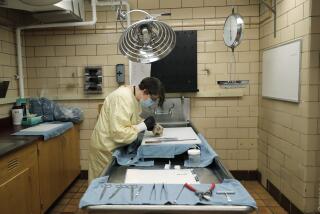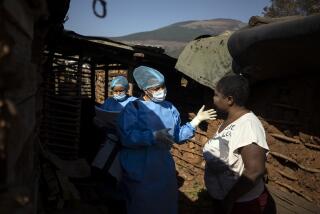The most complete Ebola genome yet: What it can tell us
- Share via
It’s a murderer on a killing spree, and now it has a new — and remarkably complete — genetic mug shot.
An international team of scientists has sequenced the RNA of 99 Ebola virus samples collected during the early weeks of the outbreak in Sierra Leone. The feat, described Thursday in the journal Science, gives researchers a powerful new tool in their effort to contain the deadly virus.
“The genome sequence of a virus is the blueprint on which that virus is built,” said Pardis Sabeti, the Harvard geneticist who helped oversee the study. “Diagnostics are built on knowing that sequence; vaccines are also built using genome sequences. And if you want to build those as best you can, you want to know what the virus looks like today.”
Scientists are already scouring that sequence for clues to help them design effective drugs and vaccines. It could take years to find them all, said Sabeti, who studies infectious diseases at Harvard and at the Broad Institute in Cambridge, Mass.
For now, evidence embedded in the RNA reveals that the Ebola virus responsible for killing at least 1,552 people so far originated with a single transmission from an animal to a human in Guinea. It also shows that this lineage, which first emerged in humans in 2013, diverged from other variants of Ebola in 2004.
Sabeti and her team began sequencing Ebola samples in June, just days after the virus was first detected in Sierra Leone on May 25. The results have been available to scientists on the National Center for Biotechnology Information’s website since mid-June, almost as soon as the sequencing machines spit them out.“We want to enable everyone in the scientific community to look at the genetic sequences at once and crowd-source a solution,” she said.
The urgency for better treatments is real for Sabeti and her colleagues. Five of the study co-authors in Sierra Leone have died of Ebola since contributing to the research.
Among them were Dr. Sheik Humarr Khan, who had 10 years’ experience treating patients who contracted deadly viruses; Mbalu Fonnie, a senior matron of nursing and midwife; lab technician Mohamed Fullah; and nurses Alex Moigboi and Alice Kovoma.
“It has been an emotional time for us,” said study co-leader Stephen Gire, a research scientist at Harvard and the Broad Institute who studies the evolution of viruses. “It makes us want to work harder to get this information out there.”
The 99 sequences described in the study were collected from 78 patients seen at Kenema Government Hospital during the first three weeks of the outbreak. Samples were taken twice from some patients, so that researchers could see how the virus mutates in a single person.
The hospital was primed for Ebola detection. Doctors and other staff there had been working with Sabeti’s lab since 2007, using a variety of diagnostic techniques at an on-site lab to detect another deadly disease called Lassa fever. When the American team learned of the Ebola outbreak in nearby Guinea in March, it quickly helped the Sierra Leone hospital set up surveillance for that virus as well.
The hospital screened patients for two months before the first test came back positive. Since then, more than 1,000 people in Sierra Leone have had laboratory-confirmed infections; at least 422 have died, according to the World Health Organization.
Hours after the first Ebola case was detected in Sierra Leone, a member of Sabeti’s team at Harvard got on a plane to help hospital workers prepare samples of the virus to send back to Boston for analysis.
The Sierra Leone team brought blood from patients directly to the Kenema Hospital lab, where it was spun in a centrifuge to separate the plasma from the red and white blood cells. Lab technicians then mixed a few drops of the plasma with a pink chemical solution that breaks down all the proteins, so the virus is no longer dangerous.
“It’s sort of like how once you crack open an egg and cook it, those proteins can no longer become a chicken,” Gire said. “We are essentially doing that to the virus, but we are using chemicals rather than heat.”
At Harvard, the RNA was removed from the samples and converted to complementary DNA. This was used to construct “libraries” that could be fed into sequencing machines. The samples were analyzed enough times to get 2,000 reads for each DNA nucleotide, according to the study.
Members of Sabeti’s team donned face shields, disposable gowns and two layers of gloves as they assembled the sequencing libraries around the clock. As a result, the team was able to get the first samples up on the Internet just 12 days after it received them.
The achievement was “nothing short of breathtaking,” said Dr. Anthony S. Fauci, director of the National Institute of Allergy and Infectious Diseases, who wasn’t involved in the study.
“To get a whole genome sequence could take four or five months,” added Charles Chiu, who studies viral metagenomics at UC San Francisco and was not involved in the study either. “This is the largest sequence of Ebola viruses ever done, and they did it in less than a month.”
The Ministry of Health and Sanitation in Sierra Leone was able to trace the country’s first cases to a group of 14 women who attended the burial of a traditional healer in Guinea. Ebola is transmitted through direct contact with infected blood, bodily fluids or organs, so it’s likely these women contracted the disease while preparing the body for burial and handling it during the funeral.
Samples collected from 12 of the women were among those sequenced in the Science study, allowing the research team to discover that the encounter with the healer brought two genetically distinct lineages of the virus into Sierra Leone. Whether the healer contracted both strains of the virus while tending to Ebola patients and passed them on to her followers, or whether one of the strains came from another person at the funeral may never be known.
Initial analysis of the genomic data has also helped the researchers understand the deeper history of the virus. The first case of Ebola was documented in 1976, but the virus probably existed long before that, scientists say. Previous genetic studies suggest that an ancient Ebola ancestor may have been circulating in Africa as far back as 10,000 years ago.
When there is no Ebola outbreak, the virus continues to live in the bodies of animals — probably fruit bats — that can tolerate it. When it does infiltrate the human bloodstream, it begins its dark work by attacking certain populations of white blood cells. A swarm of virus particles bonds to the outside of the target cells and punches through the cell membrane. Once the virus gets in, it hijacks the host cell to make copies of itself. Then those copies burst out, and the process starts again.
Mistakes are bound to be made in the midst of all this copy-making, and these errors are called mutations. Some mutations could make the virus more or less potent. If one arises in a stretch of RNA that has been used to detect the virus, it could go unnoticed by current diagnostic tests.
The researchers found more than 340 permanent mutations that make the 2014 Western Africa Ebola virus different from all other previous Ebola viruses. For now, the significance of those mutations is unclear; in time, scientists will be able to tell whether the severity of this outbreak was preordained by the genome, Sabeti said.
“There are hundreds of mutations that separate it from previous viruses, and hundreds that have happened during its spread, and hundreds that happened during the three weeks we collected samples,” Sabeti said. “Any one of those could have biological meaning, but at this stage we don’t know what ones, if any of them does.”
She and her team are working with health officials in Sierra Leone to collect more samples to track how the virus continues to change. She is also looking at mutations that may interfere with diagnostics. Already, they have found five changes that could affect tests used to detect the virus. The WHO said Thursday that more than 20,000 could be infected before the outbreak is over, so many more tests will be conducted.
“We are mostly interested in helping with this outbreak,” Sabeti said. “It’s like nothing I’ve seen in my lifetime.”
For more stories from the world of science and health, follow me @DeborahNetburn and “like” Los Angeles Times Science & Health on Facebook.







